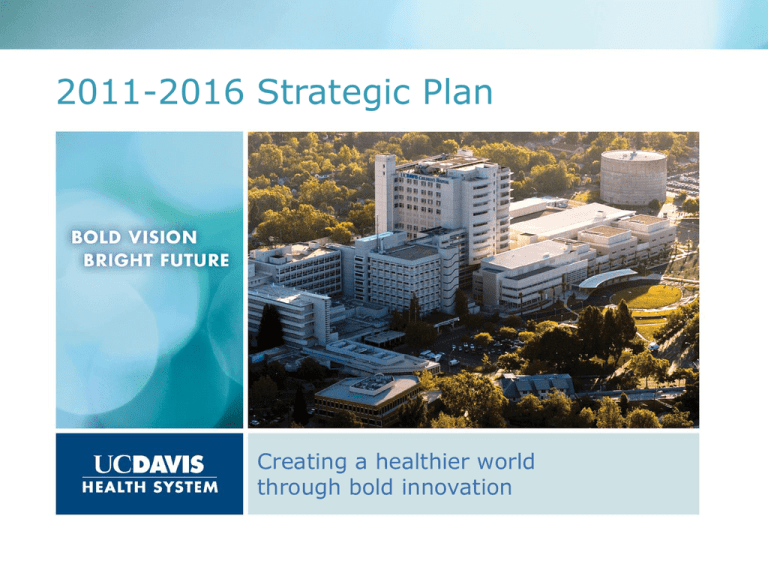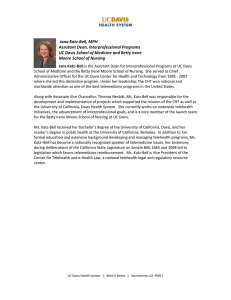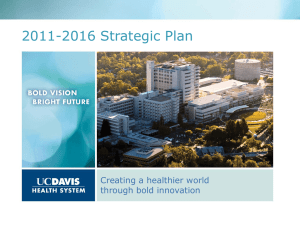2011-2016 Strategic Plan Creating a healthier world through bold innovation
advertisement

2011-2016 Strategic Plan Creating a healthier world through bold innovation 2011-2016 STRATEGIC PLAN Table of contents I. II. Global direction 1 Mission and vision statements 2 Guiding principles 3 Organizational focus areas 4 Strategic direction 5 Goal 1: Person- and family-centered care 6 Goal 2: Social responsibility and leadership 10 Goal 3: Interprofessional education to shape the future 15 Goal 4: High-impact research 20 Goal 5: Excellence in people 24 Goal 6: Collaborative organizational culture 28 Goal 7: Sustainable resources 32 Goal 8: Strategic use of technology 37 I. Global Direction 1 GLOBAL DIRECTION Mission and vision statements Our Mission: Improving lives and transforming health care. Our Vision: A healthier world through bold innovation. 2 GLOBAL DIRECTION Guiding principles 3 GLOBAL DIRECTION Organizational focus areas We are a comprehensive academic health system that strives to create a healthier world through bold innovation. Anticipating the future of health and of health-care needs, we have identified these four areas of focus that will have a high impact on individual, family, community and population health. 4 II. Strategic Direction 5 STRATEGIC DIRECTION GOAL 1: PERSON- AND FAMILY-CENTERED CARE Improve health by placing the persons and families we serve at the center of care 6 STRATEGIC DIRECTION Goal 1: Person- and family-centered care Strategy 1.1 High-quality, compassionate, person-focused care: Provide clinical programs that deliver high-quality, compassionate, effective care centered on the needs of individuals and families. Strategy 1.2 Enhanced clinical services through academic expertise: Apply academic expertise to enhance quality and innovation in health. Strategy 1.3 Robust primary care: Pursue community-wide solutions to ensure care to the communities and populations that we serve. 7 STRATEGIC DIRECTION Goal 1: Person- and family-centered care Strategy 1.1 Tactics High-quality, compassionate, person-focused care: a. Serve as a seamless, person-centered, responsive health system and culture for the people we serve. b. Ensure timely, coordinated, accessible care to individuals and their families. Provide clinical programs that deliver high-quality, compassionate, effective care centered on the needs of individuals and families. c. Utilize technological applications to strengthen communications between patients and providers. (Links to Strategy 8.3) d. Define person-centered, compassionate care performance standards for all providers and staff and reward service excellence accordingly. e. Increase use of evidence-based practices to improve and standardize quality and cost-effectiveness of care delivery. f. Ensure cultural competency in patient and family interactions. (Links to Strategy 6.2) Strategy 1.2 Tactics Enhanced clinical services through academic expertise: a. Increase participation in clinical trials and clinical research; emphasize investigator-initiated research. b. Offer personalized medicine and individualized therapies, based on sound evidence and valid scientific study. (Links to Strategy 4.1) c. Utilize the academic expertise of our Schools of Health to apply interdisciplinary and interprofessional models of care. (Links to Strategy 3.1) Apply academic expertise to enhance quality and innovation in health. 8 STRATEGIC DIRECTION Goal 1: Person- and family-centered care Strategy 1.3 Tactics Robust primary care: a. Continue to successfully expand Programs in Medical Education (PRIME; e.g., Rural-PRIME, San Joaquin Valley PRIME). b. Leverage our integrated delivery system to coordinate care across all settings and the life span. c. Continue to expose medical students to primary care career paths. d. Effectively utilize and optimize the Primary Care Network. e. Ensure exchange of clinical data between sites and affiliated programs through the Health Information Exchange. (Links to Strategy 8.3) f. Expand affiliations and partnerships with Federally Qualified Health Centers and other appropriate primary care providers. g. Integrate educational programs to create interprofessional primary care models. h. Complete feasibility analysis, program revisions, and integration of Family Nurse Practitioner/Physician Assistant program into interprofessional education in the Schools of Health. (Links to Strategy 3.1) 9 Pursue community-wide solutions to ensure care to the communities and populations that we serve. STRATEGIC DIRECTION GOAL 2: SOCIAL RESPONSIBILITY AND LEADERSHIP Address broadly the social determinants of health and equitable delivery of health care 10 STRATEGIC DIRECTION Goal 2: Social responsibility and leadership Strategy Best practice in quality: Lead in designing and implementing best practices to 2.1 assure quality* care. Designing future models of care: Play a leading role in designing, Strategy implementing and evaluating interdisciplinary and interprofessional health care 2.2 for the future. Strategy Health policy and advocacy: Provide leadership to advance social justice and 2.3 ensure health equity. Strategy Demonstrated value: Demonstrate and articulate our value to the 2.4 communities and populations that we serve. Strategy Regional care network: Develop a regional care network of hospitals, clinics 2.5 and physician groups through partnerships and affiliations. *Based on the Institute of Medicine definition of quality as “care that is safe, effective, patient-centered, timely, efficient and equitable.“ 11 STRATEGIC DIRECTION Goal 2: Social responsibility and leadership Strategy 2.1 Best practice in quality: Lead in designing and implementing best practices to assure quality care. Tactics a. Build research strengths in evidence-based health care and best practice dissemination. b. Develop quality and safety standards and treatment guidelines. c. Strengthen educational programs and institutional competencies to achieve high quality care throughout UC Davis Health System. d. Demonstrate impact of best practice. Strategy 2.2 Designing future models of care: Play a leading role in designing, implementing and evaluating interdisciplinary and interprofessional healthcare for the future. Tactics a. Design advanced innovative approaches to manage care for targeted populations. b. Conduct comparative effectiveness research on new models of care and new treatment modalities. c. Pursue health reform demonstration project funding. 12 STRATEGIC DIRECTION Goal 2: Social responsibility and leadership Strategy 2.3 Tactics Health policy and advocacy: a. Lead in health services research that translates into health policy, advocacy and service. Provide leadership to advance social justice and ensure health equity. b. Develop solutions to ensure care for the underserved. c. Offer health policy advocacy and expertise to government leaders. d. Marshall expertise to guide payment reform. e. Model financial stewardship to ensure optimal use of resources. (Link to Strategy 7.1) Strategy 2.4 Tactics Demonstrated value: a. Develop tools and metrics to evaluate the impact of our services. Demonstrate and articulate our value to the communities and populations that we serve. b. Engage UC Davis Health System’s internal stakeholders to embrace the vision and guiding principles and serve as ambassadors for the institution. c. Build and enhance relationships with alumni, retirees, friends and other community partners by encouraging involvement and support of health system programs. 13 STRATEGIC DIRECTION Goal 2: Social responsibility and leadership Strategy 2.5 Regional Care Network: Develop a regional care network of hospitals, clinics and physician groups through partnerships and affiliations. Tactics a. Expand the UC Davis Health System regional care network by exploring all types of affiliation options with hospitals, clinics, and physician groups that support UC Davis Health System missions of clinical care, teaching or research. b. Optimize operational and data sharing and integration processes to ensure the regional networks operate efficiently and achieve goals. c. Establish oversight and reporting capabilities to optimally manage regional network. 14 STRATEGIC DIRECTION GOAL 3: INTERPROFESSIONAL EDUCATION TO SHAPE THE FUTURE Prepare well-qualified health care professionals, researchers, educators, staff and leaders who will shape the future 15 STRATEGIC DIRECTION Goal 3: Interprofessional education to shape the future Strategy 3.1 New interdisciplinary and interprofessional models: Develop new models of interdisciplinary and interprofessional education in the schools of health and across the campus. Strategy 3.2 Education for a skilled health-care workforce: Provide educational opportunities for all to ensure the availability of a well-prepared health-care workforce for the future. Strategy 3.3 Effective educators: Engage individuals throughout the organization to enhance their role as educators. 16 STRATEGIC DIRECTION Goal 3: Interprofessional education to shape the future Strategy 3.1 Tactics New interdisciplinary and interprofessional models: a. Provide dynamic curricula that effectively educate the next generation of leaders in medicine, nursing, health informatics, public health, biomedical research using interprofessional approaches. Develop new models of interdisciplinary and interprofessional education in the schools of health and across the campus. b. Expand outstanding graduate educational programs that build on our academic strengths and research focus areas. c. Enhance graduate health professional educational experiences to prepare clinicians, educators and researchers for successful careers in health care and interprofessional approaches to care delivery. d. Develop interprofessional core curriculum and educational experiences in UC Davis Health System’s Schools of Health. e. Collaborate with Davis campus schools and programs to develop innovative joint programs. 17 STRATEGIC DIRECTION Goal 3: Interprofessional education to shape the future Strategy 3.2 Tactics Education for a skilled health-care workforce: a. Offer innovative training modalities including distance learning. Provide educational opportunities for all to ensure the availability of a well-prepared health-care work force for the future. b. Partner with other educational institutions and providers to provide educational opportunities. c. Incorporate emerging trends and workforce needs into program planning and implementation. 18 STRATEGIC DIRECTION Goal 3: Interprofessional education to shape the future Strategy 3.3 Tactics Effective educators: a. Establish an academy of educators that values expert educators and brings together a community of faculty to foster excellence, innovation and scholarship in health sciences education and that develops educational leaders for the future. Engage individuals throughout the organization to enhance their role as educators. b. Provide incentives to faculty to be excellent educators and to reward quality educational activities. c. Promote the requirement for educator evaluation in the merit and promotion process. d. Strengthen faculty educator development programs. e. Serve as a resource for building projects and interdisciplinary teams that contribute to scholarship in education. f. Foster the development of innovative teaching programs in areas such as interprofessional education and around interdisciplinary themes such as rural health, health policy, and telemedicine, integrated curricula. g. Empower patients and families to participate in educating faculty, staff, students and trainees. 19 STRATEGIC DIRECTION GOAL 4: HIGH-IMPACT RESEARCH Increase the scope, quality and impact of our innovative research 20 STRATEGIC DIRECTION Goal 4: High-impact research Strategy 4.1 High-quality, high-impact research: Optimize the impact of our research across the full continuum to improve health in the new era. Strategy 4.2 Team science: Prioritize team science and interdisciplinary projects that significantly improve health care delivery and health outcomes. Strategy 4.3 Outstanding research administration: Advocate for an outstanding research management infrastructure to optimally and proactively support faculty, staff and students to design, implement and manage research. Strategy 4.4 Collaborations and partnerships: Strengthen collaborations with partners to create novel interdisciplinary and interprofessional programs, approaches and projects. 21 STRATEGIC DIRECTION Goal 4: High-impact research Strategy 4.1 Tactics High-quality, highimpact research: a. Expand research related to the health system’s focal points (cancer, cardiovascular health, neuroscience, injury and healing) to impact individuals, families, local and global communities and the population. Optimize the impact of our research across the full continuum to improve health in the new era. b. Further strengthen interactions between researchers and clinicians by building interdisciplinary research teams throughout the health system. c. Ensure supporting infrastructure, cores and facilities for research across the continuum. (Links to Strategy 7.4) d. Develop a bio-repository of health information that can be used for personalized medicine. (Links to Strategy 8.1) e. Strengthen technology transfer. (Links to Strategy 4.3) Strategy 4.2 Tactics Team science: a. Develop a culture of team science research at UC Davis Health System; increase the number of center grants received by faculty. Prioritize team science and interdisciplinary projects that significantly improve health care delivery and health outcomes. b. Create a searchable database of UC Davis Health System research and investigators to identify potential collaborators. c. Enhance researcher-industry partnerships. d. Build strong collaborative research programs with researchers across UC Davis. e. Provide incentives for team science and interdisciplinary projects; ensure that faculty promotions recognize collaborative research for faculty investigators as part of their portfolio. (Links to Strategy 5.1) 22 STRATEGIC DIRECTION Goal 4: High-impact research Strategy 4.3 Tactics Outstanding research administration: a. Promote a customer service orientation by establishing service standards across the UC Davis Health System research enterprise for research management and infrastructure. Advocate for an outstanding research management infrastructure to optimally and proactively support faculty, staff and students to design, implement and manage research. b. Regularly monitor customer service performance data; recognize and reward high performers. c. Work with UC Davis Office of Research to deliver optimal research administration functions. Strategy 4.4 Tactics Collaborations and partnerships: a. Strengthen research collaborations across UC Davis and with other UC campuses and other academic partners. Strengthen collaborations with partners to create novel interdisciplinary and interprofessional programs, approaches and projects. b. Build strong partnerships with industry and private foundations. c. Develop a committee to oversee effective, coordinated and ethical corporate relationships. d. Establish strong affiliations with regional physicians and institutions for cooperative clinical trials. 23 STRATEGIC DIRECTION GOAL 5: EXCELLENCE IN PEOPLE Attract, retain and mentor excellent and diverse faculty, staff, students, trainees and leaders 24 STRATEGIC DIRECTION Goal 5: Excellence in people Strategy 5.1 High-quality faculty, staff and leadership: Retain, attract and develop talented and diverse faculty, staff and leaders that bring national and international distinction to UC Davis Health System. Strategy 5.2 High-quality students and trainees: Attract, develop and educate a diverse body of students and trainees who are talented, share the values of our organization and will become future leaders. Strategy 5.3 Lifelong learning: Create an optimal lifelong learning environment that nurtures and supports ongoing career growth and development. Strategy 5.4 Outstanding performance: Recognize and reward people who responsibly push boundaries through creativity, passion, risk-taking and achievement. 25 STRATEGIC DIRECTION Goal 5: Excellence in people Strategy 5.1 Tactics High-quality faculty, staff and leadership: a. Be an employer of choice by developing innovative workplace models and a just culture that is supportive and collaborative. Retain, attract and develop talented and diverse faculty, staff and leaders that bring national and international distinction to UC Davis Health System. b. Promote UC Davis Health System’s unique opportunities for interprofessional and interdisciplinary education, research and models of care. Strategy 5.2 Tactics High-quality students and trainees: a. Provide top-notch educational experiences for students, residents, post-doctoral scholars and post-graduates in order to prepare graduates to define the future of health and health care across missions. Attract, develop and educate a diverse body of students and trainees who are talented, share the values of our organization and will become future leaders. c. Provide opportunities for career advancement. d. Offer competitive salaries and benefits. b. Leverage UC Davis Health System’s advanced technology and assets to develop innovative curricula in schools of health. (Links to Strategy 8.1) c. Provide appropriate nurturing environment for development. 26 STRATEGIC DIRECTION Goal 5: Excellence in people Strategy 5.3 Tactics Lifelong learning: a. Ensure the provision of quality continuing medical- and health-education programs. Create an optimal lifelong learning environment that nurtures and supports ongoing career growth and development. b. Provide access to professional development and career advancement opportunities for all at UC Davis Health System. c. Enhance lifelong learning options, including simulation training. d. Establish a comprehensive, innovative mentoring academy that values expert mentoring in research and career development, and fosters personal and institutional growth that leads to recruitment and retention of outstanding trainees, faculty, staff and leaders. Strategy 5.4 Outstanding performance: Recognize and reward people who responsibly push boundaries through creativity, passion, risk-taking and achievement. Tactics a. Enhance internal promotion of organizational accomplishments. b. Develop and implement mechanisms by which accountability, collaboration and performance are recognized and rewarded. c. Develop a mechanism through which innovation and risk-taking can be responsibly evaluated. 27 STRATEGIC DIRECTION GOAL 6: COLLABORATIVE ORGANIZATIONAL CULTURE Promote a culture that fosters a collaborative, diverse and effective organization at all levels 28 STRATEGIC DIRECTION Goal 6: Collaborative organizational culture Strategy 6.1 Organizational communication: Strengthen communication throughout the organization to develop a culture that encourages innovation, collaboration, and the free exchange of ideas. Strategy 6.2 Value diversity: Create an environment where individuals from diverse backgrounds feel included, celebrated and respected. Strategy 6.3 Transparent, strategic decision-making: Establish and implement a transparent process through which strategic decisions will be made. 29 STRATEGIC DIRECTION Goal 6: Collaborative organizational culture Strategy 6.1 Tactics Organizational communication: a. Develop innovative communication approaches for internal and external audiences. Strengthen communication throughout the organization to develop a culture that encourages innovation, collaboration, and the free exchange of ideas. b. Leverage technology and news media to engage internal and external audiences. (Links to Strategy 8.3) c. Ensure consistent and timely communication and messaging. d. Continue efforts to strengthen the brand identity of UC Davis Health System in all mission areas. Strategy 6.2 Tactics Value diversity: a. Recognize and celebrate successful diversity activities and initiatives. Create an environment where individuals from diverse backgrounds feel included, celebrated and respected. b. Strengthen outreach programs that attract greater numbers of diverse candidates for candidate pools. (Links to Strategy 5.1) c. Emphasize diversity as a competitive advantage. (Links to Strategy 1.1) d. Enact the Diversity and Community Engagement Framework. 30 STRATEGIC DIRECTION Goal 6: Collaborative organizational culture Strategy 6.3 Tactics Transparent, strategic decision-making: a. Align resource allocation processes and decisions with long-term strategic goals identified in the UC Davis Health System’s Strategic Plan. Establish and implement a transparent process through which strategic decisions will be made. b. Strengthen systems to improve our capacity to monitor and communicate decision-making. (Links to Strategy 8.3) c. Strengthen communication mechanisms for feedback and reporting back on changes made in response to input. d. Create appropriate venues for constructive dialog and ongoing strategy development. 31 STRATEGIC DIRECTION GOAL 7: SUSTAINABLE RESOURCES Ensure sustainable utilization of resources and infrastructure that provides optimal support for all mission areas 32 STRATEGIC DIRECTION Goal 7: Sustainable resources Strategy 7.1 Optimal use of resources: Appropriately allocate resources and demonstrate value for investments made. Strategy 7.2 Diversification of revenue: Diversify revenue sources to establish a financially strong organization that is responsive to changing financial conditions. Strategy 7.3 Culture of philanthropy: Effectively engage our communities to develop a broad base of philanthropic support. Strategy 7.4 Physical infrastructure: Ensure state-of-the-art facilities and infrastructure for all mission areas. Strategy 7.5 Environmental stewardship: Use evidence-based approaches to evaluate and reduce our impact on the environment and reduce our dependence on nonrenewable energy. 33 STRATEGIC DIRECTION Goal 7: Sustainable resources Strategy 7.1 Tactics Optimal use of resources: a. Align the resources of the hospital, schools, departments and centers. Appropriately allocate resources and demonstrate value for investments made. Strategy 7.2 Diversification of revenue: Diversify revenue sources to establish a strong organization that is responsive to changing financial conditions. b. Design and implement infrastructure that supports the vision for the Schools of Health with shared resources and structures. Tactics a. Increase extramural research support for all areas of research across the UC Davis Health System research continuum. (Links to Strategy 4.1-4.4) b. Advocate to UC Davis and UC Office of the President to ensure a fair and sustainable distribution of resources. c. Strengthen our ability to tap federal and private resources for innovation in all mission areas. d. Leverage our resources and relationships to ensure a strong position with all payer sources. 34 STRATEGIC DIRECTION Goal 7: Sustainable resources Strategy 7.3 Tactics Culture of philanthropy: a. Foster strong relationships with alumni, retirees and friends. Effectively engage our communities to develop a broad base of philanthropic support. b. Effectively utilize UC Davis Health System and UC Davis development offices. c. Provide development workshops for faculty and leadership to recognize and leverage philanthropic opportunities. d. Successfully complete the Comprehensive Fundraising Campaign. e. Design and engage effective advisory councils to advance philanthropy. f. Involve all centers, departments and institutes in developing donor relationships to meet our fundraising goals. Strategy 7.4 Tactics Physical infrastructure: a. Expand space for Schools of Health. (Links to Strategy 3.1) Ensure state-of-the-art facilities and infrastructure for all mission areas. b. Procure additional research space. (Links to Strategy 4.1-4.2) c. Ensure highly functional, accessible and attractive clinical facilities. (Links to Strategy 1.1) d. Ensure sufficient support staff to operate facilities. 35 STRATEGIC DIRECTION Goal 7: Sustainable resources Strategy 7.5 Environmental stewardship: Tactics a. Identify novel ways to achieve environmental stewardship in each of UC Davis Health System’s mission areas. Use evidence-based approaches to evaluate and b. Incorporate the principles of energy efficiency and sustainability in all reduce our impact on the capital projects, renovation projects, operations and maintenance within environment and reduce our budgetary constraints and programmatic requirements. dependence on nonrenewable energy.* (Links c. Minimize the use of non-renewable energy sources and apply to Strategy 7.1) conservation measures that reduce energy consumption. d. Incorporate alternative means of transportation to/from and within the campus to improve the quality of life on campus and in the surrounding community. e. Minimize the amount of Health System-generated waste sent to landfill. f. Utilize UC Davis Health System and UC purchasing power to meet its sustainability objectives. * Paraphrased from UC Policy on Sustainable Practices, 9/1/09; tactics reflect those presented this report. 36 STRATEGIC DIRECTION GOAL 8: STRATEGIC USE OF TECHNOLOGY Expand the strategic use of technologies to enhance research, education and clinical care 37 STRATEGIC DIRECTION Goal 8: Strategic use of technology Strategy 8.1 Innovative health technology: Be a national leader in informatics and health-care technology. Strategy 8.2 Technology leaders of the future: Set the standard for applied informatics that catalyze technological innovation to improve health outcomes. Strategy 8.3 Enabling technologies: Effectively deploy technologies to support goals and missions of UC Davis Health System and its partners. 38 STRATEGIC DIRECTION Goal 8: Strategic use of technology Strategy 8.1 Innovative health technology: Be a national leader in informatics and healthcare technology. Tactics a. Continue to lead in the use of information technology as evidenced by earning the Healthcare Information and Management Systems Society (HIMSS) Analytics Electronic Medical Record (EMR) adoption model Level 7, and the HIMSS Nicholas E. Davies Award of excellence in the implementation and use of health information technology. b. Deploy a modern clinical research IT infrastructure that includes genetics/molecular support, advanced bio-repository software, the next generation population longitudinal database, and required support tools for investigators and grant management capabilities. c. Ensure that UC Davis Health System can share required content with all relevant clinical and research partners. d. Create and deploy a Meta registry tethered to UC Davis Health System’s electronic health record (EHR) to support disease registries, outcomes analysis, and other types of required analysis and research. 39 STRATEGIC DIRECTION Goal 8: Strategic use of technology Strategy 8.2 Technology leaders of the future: Set the standard for applied informatics that catalyze technological innovation to improve health outcomes. Tactics a. Create a new Informatics, Telehealth, and Innovative Technologies Institute to coordinate Informatics teaching and research and integrate and leverage UC Davis informatics resources. b. Deliver Informatics academic educational programs that ensure UC Davis Health System and the community have highly skilled Informatics professionals to staff and support health technology and innovation. c. Ensure adequate numbers of Informatics faculty are created to educate and support the next generation of health professionals. d. Deploy modern educational technology infrastructure to support all types of academic, in-service, and distance learning technologies needed for the UC Davis Schools of Health and staff development programs. e. Become a national leader in creating and using advanced simulator training technologies that are integrated with modern clinical and educational technologies. f. Become a national leader in creating and maintaining evidence-based online clinical knowledge that integrates with EHRs, disease registries, clinical research, and drives educational curriculum. 40 STRATEGIC DIRECTION Goal 8: Strategic use of technology Strategy 8.3 Enabling technologies: Effectively deploy technologies to support goals and missions of UC Davis Health System and its partners. Tactics a. Design and deploy the next generation telemedicine software infrastructure that leverages modern Electronic Health Records (EHR), health information exchange, and outcome analysis capabilities. b. Fully deploy all relevant Epic clinical and financial software modules. c. Replace outdated UC Davis Health System financial, human resource, and operational software applications. d. Ensure mission critical information technologies used by the organization are stable; replace the obsolete UC Davis Health System data centers with modern tier III data centers. e. Create an organization-wide business and clinical continuity plan. 41





